Events
Soviet plaque taken down!
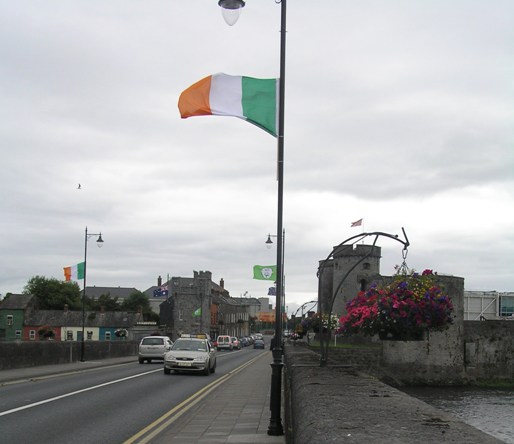
As part of the inner city
renewal, Thomond Bridge was recently adorned with a series of new street
lighting. It represents a marked improvement on the 'old' ESB poles which
proved to be really useful for an assortment of posters in the recent
elections.
However, one of the
casualties of this welcome exercise was the plaque denoting the site of
Thomond Bridge as a major British Army barricade during the Limerick
Soviet. Indeed the iconic picture of the barricade is a symbol of the
1919 struggle against British Militarism! The plaque was unveiled by the
then Socialist Mayor Joe Harrington as part of the Limerick Soviet
Commemoration Committee's 'eighty years' celebration in April 1999.
No doubt, the Limerick Civic
Project has securely stored the plaque in a warehouse somewhere in the
city. The LSCC is confident that the plaque will be again displayed in
the environs of Thomond Bridge where it has acted as a landmark for
tourists and citizens alike for the past decade?

Possible alternative sites for the plaque. Beside the Treaty Stone
above or in Robert Byrne Park below

Grave of Robert Byrne revealed
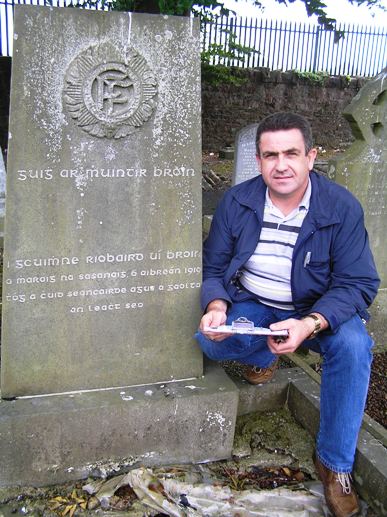
Mike McNamara, President of the Limerick
Council of Trade Unions, carried
out some research and tracked down the grave of Robert Byrnes, the man
whose death sparked the Limerick Soviet in 1919. In the sketch below
of Mount St Laurence Graveyard the location of the grave is shown.
More later.
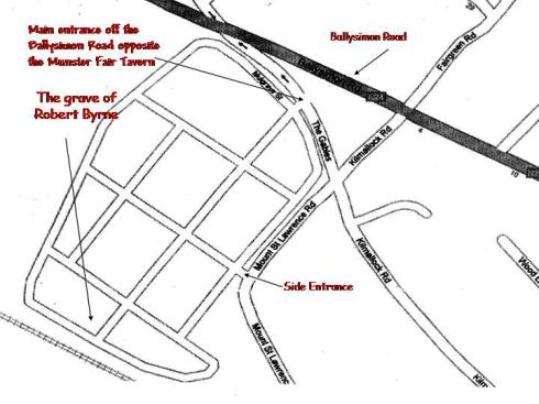
Robert
Byrne Park is officially opened.

Limerick City Manger, Mr Mackey, Mayor
John Gilligan and Mike McNamara, President of the Limerick Council of
Trade Unions at the unveiling of the plaque commemorating the Limerick
Soviet. The plaque stands on the new Riverside Park which was
officially opened as Robert Byrne Park by the Mayor. It was
the death of Robert Byrne in April 1919 that sparked the events known as
the Limerick Soviet. The opening was attended by relatives of Robert
Byrne, Trade Union leaders and local and national politicians (some of
whom looked rather uncomfortable but there are elections on!!!)
Mayor John Gilligan is to be
congratulated on ensuring that the memory of the Limerick Soviet is
preserved in the shape of this lovely park which will be used by the
people of Limerick for many years to come.
Click here for more photos of the official
opening
Report on the Limerick Soviet 90th. Anniversary
Commemorations
The Limerick Soviet Commemoration Committee organised a series of
activities with prominent speakers over the weekend April 17 - April 19.
The activities commenced with the launch by Mike Mc Namara, President of
the Limerick Trades Council of the fourth edition of D.R. O’Connor,
Lysaght’s The Story of the Limerick Soviet. O’Connor Lysaght, a Dublin
historian, compared the two week’s of the self government and resistance
to British militarism as similar to the early days of the 1871 Paris
Commune.
In his foreword to the 4th. edition, Mayor Gilligan announced his
intention to open the Robert Byrne Curragower Park in Clancy Strand in
May. Robert Byrne’s attempted rescue from the City Home and fatal shooting
led to the imposition of martial law in Limerick in April 1919.
On Saturday April 18th. the Hunt Museum played host to a seminar on the
theme , ‘The Limerick Soviet 90 years on’. Liam Cahill, broadcaster and
author of Forgotten Revolution, reminded the audience that on April 18th.
1919, Good Friday, the Limerick Soviet was at its peak. The workers of
Limerick governed the city through its democratic organisations. Nothing
could move in or out without the permission of the Limerick Council of
Trade Unions, flagrantly resisting the attempts by the British Military to
impose their Local Pass on the citizens.
Jack O’Connor, General President of SIPTU used the forum to call for a
Social Dividend from the Government and Employers in the talks that were
due to resume on Wednesday 22nd. April. He also cited the case of an
employee of SR Technics, who after 45 years service with the company was
told that his pension was worthless. He went on to call on the Government
to offer a multi billion Euro plan to protect private worker pensions, if
the talks were not to collapse.
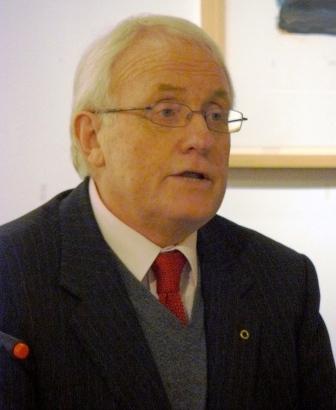

Liam Cahill and Jack O'Connor
Austin Harney, a fulltime public sector union official travelled from
London especially to present fraternal greetings to the Limerick Soviet
Committee. Jan O’Sullivan, Labour TD and Maurice Quinlivan, Sinn Féin
local election candidate and Alan Kelly Munster candidate candidate for
Labour in the European elections also attended the meeting.
The weekend’s activities concluded on Sunday April 19th. with a Workers’
Walk through the city scenes of the Soviet. Local historian, Dominic Haugh
who has chosen the subject for his PhD, conducted the highly informative
tour. His detailed account of the rescue of Robert Byrne from St.
Camillus’ was a revelation, even to long time students of the Soviet.
Present on the walk was Jack Hennessy, grandson of James Casey who acted
as treasurer to the Limerick Soviet. James Casey, a Labour councillor,
served as Deputy Mayor in 1921 after the murder of Mayor Clancy. He was to
serve as Mayor of Limerick from 1934 to 1936.
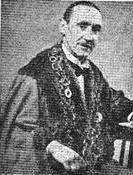
James Casey
At its conclusion, the City Museum was opened especially for the
participants, who then adjourned to nearby Katy Daly’s for Ceol agus Craic!
Pat O’Connor
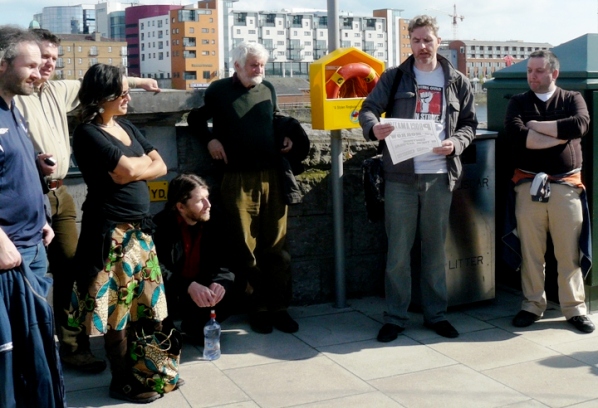
Reading the proclamation on the
Workers Walk
Mayday Reception at
City Hall marks 90th. Anniversary
On Friday May 1st., Mayor Gilligan hosted a reception for the Limerick
Council of Trade Unions to mark the 90th. anniversary of the Limerick
Soviet.
Trades Council members, old and new, attended the evening reception. The
President of the Trades Council, Mike Mc Namara of BATU, addressed the
gathering. He complimented the mayor on his role in celebrating the Soviet
as well as the Soviet Commemoration Committee on its series of activities.
The mayor also addressed the attendance on the importance of May Day.
Pádraig Malone as director of the Resource Centre spoke of its role in the
present economic climate as well as remembering the work of the late Mary
Kehilly in both the Trades Council and the Unemployed Centre.
Former mayor and TD Frank Prendergast was also in attendance and spoke of
the importance of commemorating historical events in the Labour Movement.
Jack Hennessy, grandson of former mayor and Limerick Soviet treasurer
brought along old newspaper articles on his grandfather’s succession to
the murdered Mayor Clancy.
It was a memorable evening of celebration, which fittingly commemorated
Mayday in City Hall. As the celebrations drew to a conclusion the melodic
strains of ballads remembering past struggles and icons such as Joe Hill,
James Connolly and James Larkin rang out through the halls of the Mayoral
Suite!
The following is Mayor John Gilligan
foreword to "The Story of the Limerick Soviet" by D.R. O'Connor Lysaght.
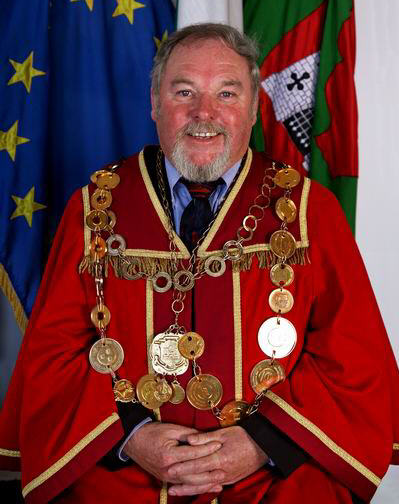
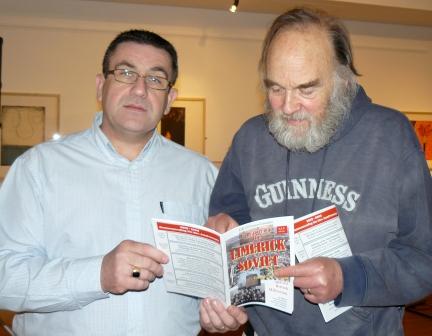
Left: Mayor John Gilligan and right Mike
McNamara LCTU with D.R. O'Connor Lysaght
It is a great
honour for me, as the 812th. Mayor of Limerick to be in the mayoralty on
this the 90th. Anniversary of what became known as the Limerick Soviet.
"The Story of the Limerick Soviet" by D.R. O'Connor Lysaght, since its
first publication in 1979 has been an ideal reference book for students
and activists. The author, a frequent visitor to Limerick, has
painstakingly recounted the day-by-day activities of this tumultuous
fourteen-day period.
The attempted rescue of IRA prisoner and Post Office worker Robert Byrne
in early April 1919 and his subsequent fatal shooting sparked off a series
of events that could conceivably have changed the whole face of European
history.
Indeed the presence in Limerick of the world press to cover the weather
hit trans Atlantic crossing brought these historic events to a global
audience. For two weeks the workers organisations in Limerick ran the city
as the British found that its writ did not run in this corner of what was
then the United Kingdom!
These stirring events occurred while Europe was coming out of the Great
War and the Soviet Union was barely in its infancy.
In my generation’s history education we were told very little of the role
that workers played. I am very pleased to note that the inspiring past of
the workers’ struggles in our city has been faithfully recounted over the
last three decades in the pages of this excellent booklet, the fourth
edition of which I am proud to be associated.
I look forward to commemorating the Limerick Soviet in various events
throughout the year. I am indeed proud that my mayoralty will mark the
occasion with the unveiling of the Robert Byrne Curragower Park on Clancy
Strand.
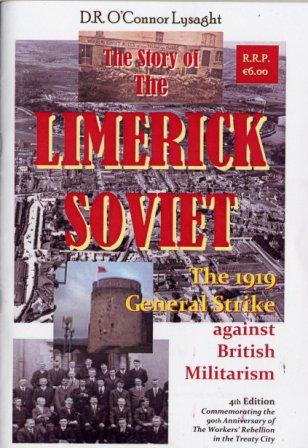
This is the 4th edition of The Story of the Limerick Soviet which carries
the above foreword by Mayor John Gilligan. It can be ordered
from the Limerick Soviet Commemoration Committee by sending €9/£9 to Pat
O'Connor, 8 Rosroe Ave, Caherdavin, Limerick. For more information
you can also click here
to e-mail Pat.
As seen from London
Between 16th
and 19th April 2009, I attended the 90th Anniversary of the Limerick
Soviet. I sent fraternal greetings from the Greater London Association of
Trades Union Councils. This anniversary may seem to be one of the least
recognised events in Irish history but certainly could be viewed as an
important epoch in workers' struggles. It is a great example of a well
organised Strike by all local Trade Unions in this particular city and it
could have escalated to the rest of Ireland and Britain. The commemorative
events of the anniversary were launched on 6th April in City Hall by John
Gilligan, the Mayor of Limerick. Along with a two week exhibition, the
events continued with the launch of 4th edition of DR O’Connor Lysaght’s
"Story of the Limerick Soviet" on 17th April. During the following day,
there was a seminar hosted by Liam Cahill, (historian and author of
"Forgotten Revolution"), Jack O'Connor (President of SIPTU, Ireland's
largest Trade Union) and Mary O'Donnell (Chair of the Limerick
Commemoration Committee). On the final day of 19th April, "The Workers'
Walk" was organised by Dominic Haugh, a postal workers' union shop steward
and local historian in which we visited the historic sites of the 1919
Strike.
In order to
provide some background information, the Limerick Soviet was established
on 6th April 1919, a few months after the Dail (the newly elected Irish
national assembly) proclaimed independence from Britain in January. It was
during this time that many people in Ireland were joining the new emerging
nationalist movement, known as the Irish Republican Army. One of them, by
the name of Robert Byrne, was a postal worker and active Trade Unionist in
Limerick City. Like most Republicans in the county, he believed in an
independent Ireland that was free for all Irish working class people from
any capitalist exploitation. But one day, his employer found an excuse to
dismiss him and his house was later searched by the authorities. As a
pistol was found, which may have been planted there, he was arrested and
imprisoned. Byrne protested against this treatment by going on hunger
strike. After some time, he became unconscious and was moved St. Camilus'
Hospital. A rescue attempt was made by a number of his comrades resulting
in mortal casualties on both sides and the fatal wounding of Robert Byrne
despite his successful escape. He died the following evening. His death
was heavily mourned throughout the city as 20,000 people attended his
funeral in protest. The British Government reacted angrily by imposing
martial law on the city with the use of troops and tanks. Thus, the local
people had to reveal their permits to the British guards on duty before
going to work.
As a result,
the local Trade Unions resorted to Strike action and set up a Strike
Committee known by the Press as the Limerick Soviet. The Strike Committee
certainly lived up to this name as a "workers' council" according to its
Russian equivalent. The British forces attempted to prevent any movement
in or out of the city and military barricades were placed on Thomond and
what is now named Sarsfield Bridge. The city was under siege and food had
to be smuggled across the Shannon from County Clare. Hearses coming from
the 'City Home' did not always contain corpses! For two weeks Limerick
became 'self ruled.' The workers, through its organisations, ran the
city. Not only did they organise their own food rations but they were
later to print their own paper currency as finances were becoming short.
Soon, the Limerick Soviet became well known at international level. It is
interesting to know that a Scottish regiment was very sympathetic by
allowing many local workers to pass without showing their permits. The
British Government sent this regiment home in order to replace them with a
more repressive one.
But
the Strike was set to escalate at national level. Already, other Irish
Trade Union Councils were sending supplies to their comrades in Limerick
and even Irish labourers in Britain were Striking in support. But by the
end of mid April, the Church and the British led TUC waned in support. It
was difficult for the people of Limerick to sustain this struggle on their
own. After much heated negotiation with the Irish representatives of the
TUC, it was agreed that British Martial Law would be lifted in return for
ending the Strike. A few days after the people of Limerick returned to
work, the British troops were withdrawn. No doubt, this industrial
action was a great success at local level, but a great opportunity for an
international Strike within Britain and Ireland was lost.
However, the
Limerick Soviet was to be the first of many struggles in the county for
the next few years. More Strikes were to follow with the establishment of
other local Soviets by the farm labourers and dairy workers of Limerick
County. Also, there were many communists in the Limerick IRA that played a
prominent role in the War of Irish Independence (1919 to 1921) and the
Civil War (1922 to 1923). But such events in Limerick, sadly, play a less
recognised part in Irish history and communism did not become a
respectable ideology here, unlike certain countries in Europe.
I would like
to thank the Limerick Commemoration Committee and the Trades Union Council
for promoting this important anniversary. References can be made to the
two books, "Forgotten Revolution" and "The Story of the Limerick Soviet"
on the website:
www.limericksoviet90.com
In reference to the Seminar of 18th April, Jack O'Connor denounced the
employers for cutting jobs, wages and even allowing loss of pensions. Like
Britain, the Republic of Ireland is undergoing a deep recession with more
unemployment and rising crime. It should not be forgotten that a Council
of the Isles (or British - Irish Council) was established under the Good
Friday Agreement of 1998. Yet, there seems to be no sign of British and
Irish Trade Unions being provided with a major role on this council
in defending workers' rights. It is important that we build greater links
between the Trade Unions of these two nations in protecting our workers
against global capitalism.
Austin
Harney,
Secretary of
Barnet Trades Union Council.

Austin
Harney addressing the Seminar at the Hunt Museum.
|

